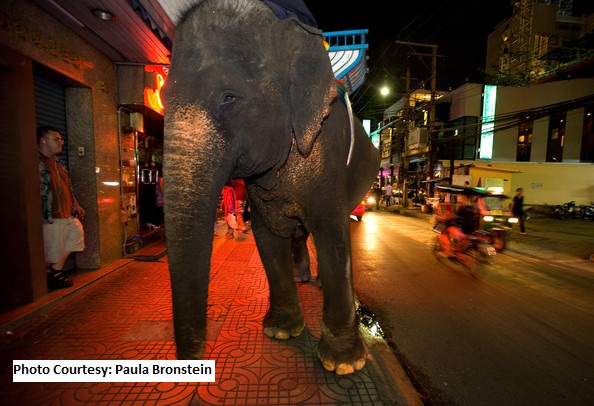The Effects of 1989 Logging Ban
 After Thailand’s deforestation, which was continually precipitated by forest destruction and illegal logging from the 1960s, it led to flash floods in the southern provinces in late November 1988. The Thai government imposed a nationwide logging ban through an emergency decree in January 1989. The logging ban in 1989 had a drastic impact and far-reaching effects on elephant populations in Thailand.
After Thailand’s deforestation, which was continually precipitated by forest destruction and illegal logging from the 1960s, it led to flash floods in the southern provinces in late November 1988. The Thai government imposed a nationwide logging ban through an emergency decree in January 1989. The logging ban in 1989 had a drastic impact and far-reaching effects on elephant populations in Thailand.
Biases in Information Processing. The decision to implement the 1989 logging ban revealed the biases in information processing. The decision was made based on availability heuristic. The estimates of probability of the flash floods were affected by how cognitively available the event was, which occurred just one year before the ban was introduced. In addition, the people encountered the flash floods personally, increasing the sensory vividness with which the risks were perceived. Hence, flash floods risks appeared to be more apparent and overrule the need for attention of the elephants in Thailand.
1) Dramatic Reduction in Employment for Working Elephants
Before 1990, over 4,000 elephants had jobs pulling logs, carrying people and goods cross-country, dragging plows, and performing in ceremonies. The ban therefore effectively rendering 70% of the working elephants in Thailand without work practically overnight. The Forest Industry Organisation (FIO), a government agency was worst hit. In 1989, the FIO owned 60% of the 306 logging licenses in the country and as a result of the ban had to lay off 50% of its mahouts and elephants (Godfrey, 2009).
Each elephant owner had to find a way to feed his animal — elephants can eat 500 pounds of food daily. Some owners turned to illegal logging, which became far more dangerous. Forcing the elephants to work faster, and feed them bananas spiked with amphetamines. Many logging elephants became drug-addicted, exhausted and ill (Holtcamp, 2012).
Bounded Rationality. The mahouts rely on overly simple mental models to generate revenue for them. They exhibited bounded rationally in their thinking and information processing whereby they consider feeding the elephants with drugs as a way to make them work faster. However, this cognitive simplifications do cause the people to overlook other problems such as neglecting the health of the elephants.
2) Transfer of Elephants From Logging to Street Begging Elephant along the streets of Bangkok.
Elephant along the streets of Bangkok.
Following the 1989 ban on logging, many mahouts brought their elephants to Thailand’s big cities to roam the streets. The mahouts would generally sell elephant snacks (bananas, sugarcane or pineapple) to tourists for them to feed the elephants. The elephants and their mahouts wandered the streets to gather sales. However, walking along the streets with heavy traffic posed their lives at danger. Due to the fact that the elephants only obtained approximately 13% of their daily food requirements during working hours, the nature of which does not comprise a healthy or sustainable diet. This puts the city elephants to scavenge on discarded food and plants polluted from car fumes, and eventually became malnourished. Despite bans on bringing elephants into Bangkok was implemented in 1997, many mahouts still risk fines and confiscation by going to town with their elephants, considering the fines as “business expenses”.
Risk Underreaction. The need to earn income for the mahout and the elephants override the safety of them. Risk estimation of facing traffic accidents or fines by government were underestimated. The failure to take preventive actions are relatively common features of human under-reaction behaviour. Today, nearly 300 elephants still beg on the streets of Bangkok (Holtcamp, 2012).
3) Decrease in Financial Revenue for Mahouts
The legal employment opportunities available to mahouts and their elephants after the logging ban were few and the revenue generated for the mahout were, in most cases, low. The work in tourist camps were described as “unfair employment practices”. A single elephant can be owned by two or three mahouts working in partnership. One elephant therefore has to generate revenue for two or three families. This incurred the need for the mahouts to increase the workload of the elephants and each mahout will tend to maximise their time with the elephant.
Psychological Stress Theory. This threat is perceived by the mahout as uncontrollable. The mahouts face the stress of earning sufficient money to support their families. The daily heavy workload of the elephants is viewed as necessary in order to earn a living for the mahout’s families. This psychological stress theory is seen as a denial response to lessen their anxiety feelings that is caused by an uncontrollable event. They apply the use of emotion-focused coping strategy: fatalism. Accepting that the threat is unavoidable and a cessation of any attempts to avoid it. This put the threat at further risk because it stops a person from trying further efforts to gain information or exert control that might be effective. In other words, the mahouts feel that there is no other better alternative and do not make any attempt to salvage the situation.

